Beach Mosquito Control District (BMCD) in Florida’s Panama City Beach has introduced a brand-new Bell 505 into service, fitted with a newly designed, first-of-type tank system after years of operating aging OH58s.
Replacement Needed
BMCD is an independent special taxing district, conducting mosquito control over an area of about 70,000 acres around Panama City Beach. Its helicopter operations commenced with the Hughes 300/TH55 and progressed to ex-military OH58s (Bell Kiowas), that served admirably for many years. The Kiowas however, are old airframes with a very limited remaining lifespan so their looming replacement posed serious questions for the district. Current full-time pilot Drew Lewis now flies mosquito control operations for BMCD and he explained the rationale behind the switch to the Bell 505, explaining, “This all happened before I came on board but it’s a pretty simple answer really. The 58s were timing out and they wanted to plan for the long term, not just a quick solution. It’s a small district and although we have a healthy budget, we can’t abuse taxpayer dollars and buying something like a brand-new 407 would be more than we need.”
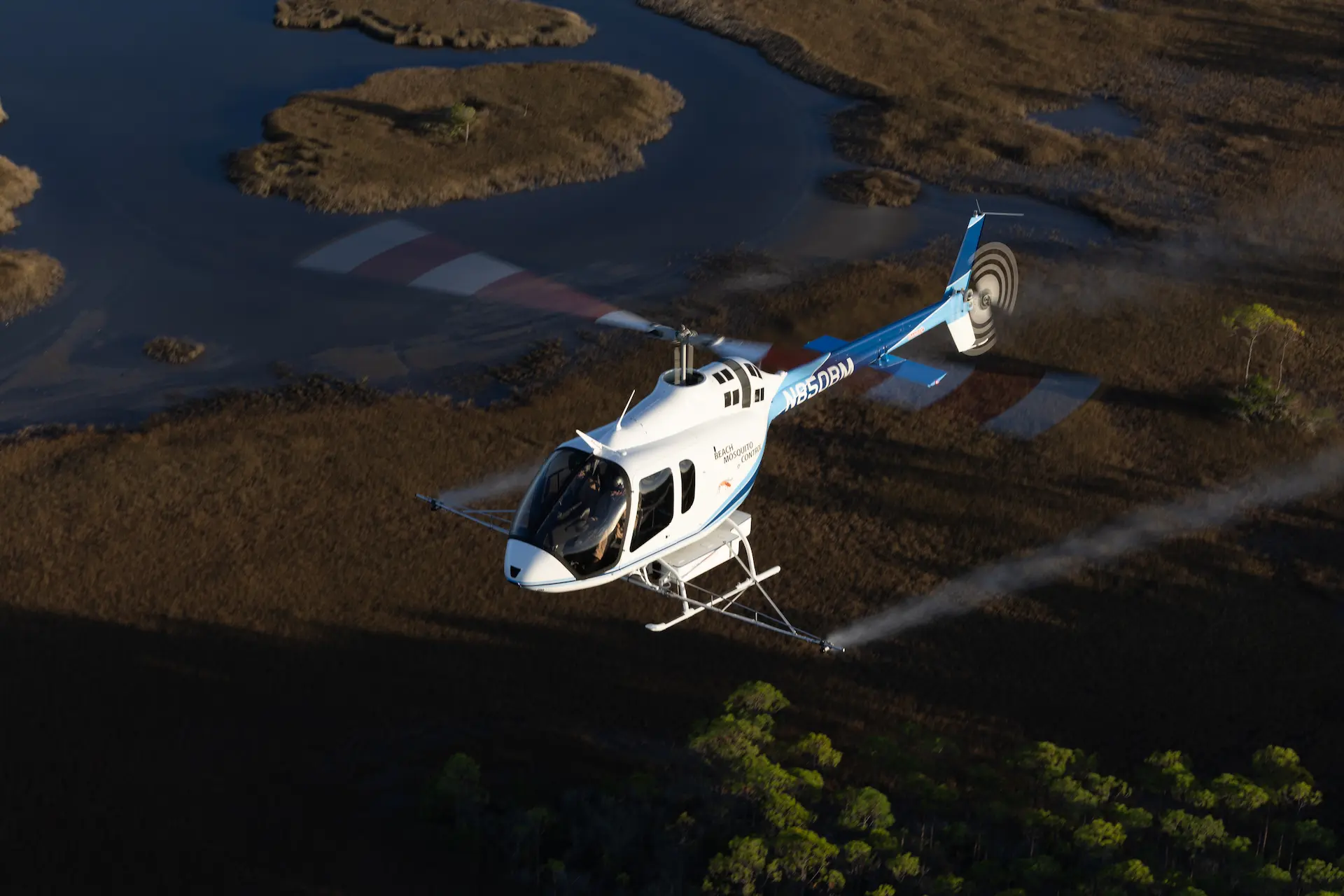
Lewis said that options for a helicopter replacement had included obtaining another OH58, which would still have a limited lifespan, or switching to an Airbus (AS350) or maybe a Robinson R66. “The problem with a Kiowa or an R66 is that you’re operating on the edge of your performance envelope, with gross weight being the limiting factor. The 505 falls right in the middle though and it’s considerably cheaper than an Airbus.”
“We don’t need an Airbus and although there’s nobody out there with a working solution on the 505, it seemed like it fit the bill really well for us. It’s a good, middle-of-the-road option that doesn’t cost too much so they made the decision to go that way.”
Bell 505 Decision
With the decision made to go down the 505 route, a potentially prickly problem then reared its head. With no 505 anywhere in the world yet fitted with an underbelly tank and spray system, a new product was required to be designed and manufactured for the type. Ensuing conversations with Michael Powell, the owner of well-established tank system manufacturer Isolair Inc, led to the subsequent development of an underbelly tank system for the 505 airframe fitted with Micronair’s electrically driven atomizers. This makes BMCD the world’s first operator of a tanked 505 for mosquito control. Lewis did remark that a New Orleans agency recently obtained its own new 505 and so will now be able to utilize the same Isolair system, but he also commented that with the 505 being a new, untested platform, many in the industry are understandably skeptical of its selection for mosquito control operations. Once the 505 is fully operational Lewis also hopes to install a small on-board flushing-tank system to flush out the spray equipment after the completion of a mission.
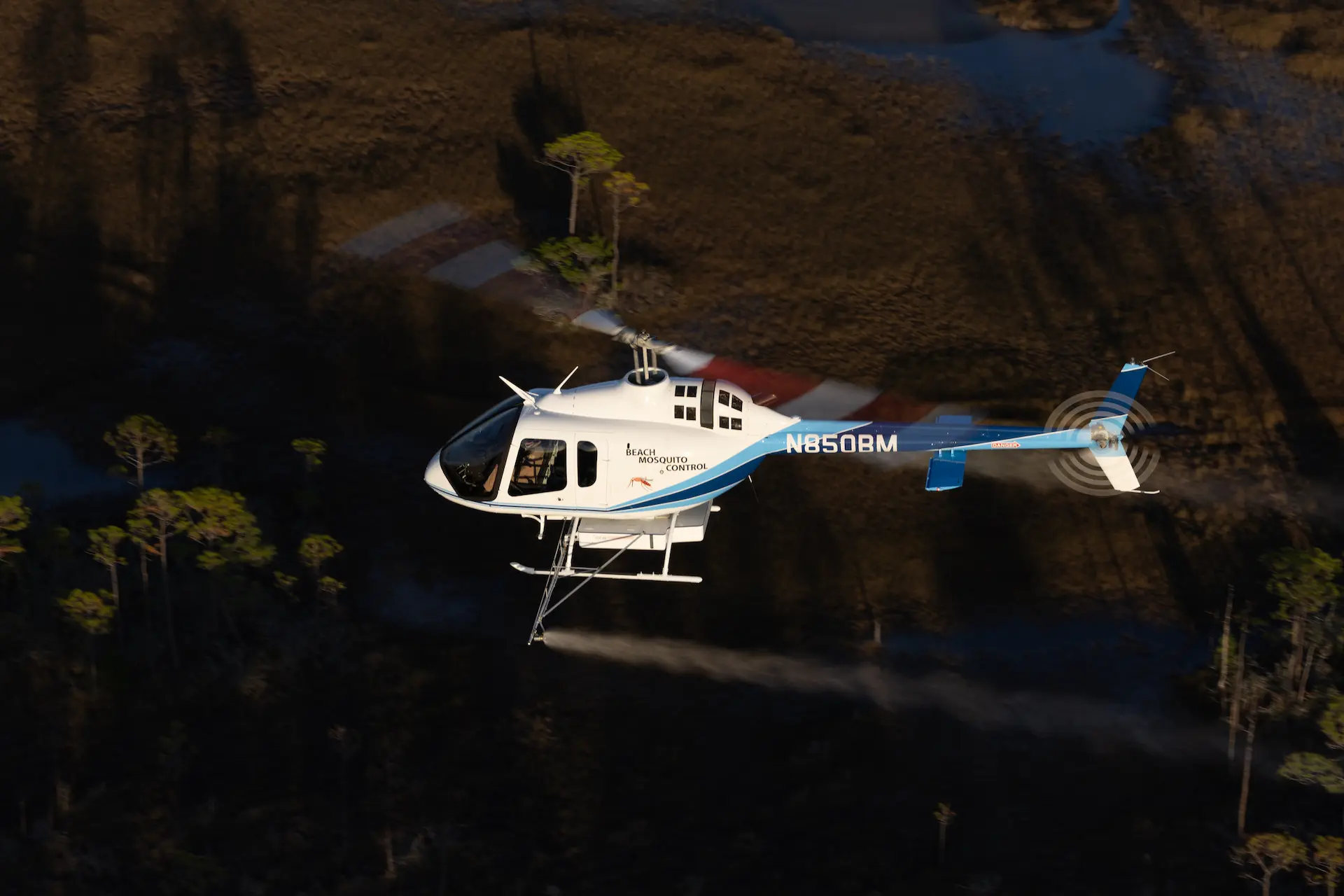
Responsible Control
The BMCD’s area of responsibility is only fifteen miles long and less than five miles wide, largely serviced by the fleet of ground vehicles on larvicide and adulticide missions, with mosquito fish also delivered and dispersed for natural mosquito control. “We don’t treat most of the district because there’s nobody up there in a lot of it under West Bay, so why waste money killing mosquitos that aren’t biting anybody?” Lewis commented. He advised that northern Florida is fortunate to have a cool enough winter to significantly knock back mosquito numbers, but the annual season is still typically nine to ten months long. The district’s helicopter operation runs with just a single pilot position and after the previous pilot retired in 2018, the operation managed for some time with a part-time sheriff’s pilot. That pilot then passed away suddenly and the new 505 sat idle for some months until Lewis joined the district, so an expensive mechanical refresh taking several months was then required on the Safran engine, which returned to service in June 2023. Factory turnaround times for work on the Safran engines are long, which can be a challenge for operators, but the manufacturer is not alone in this regard and Lewis stated that his Safran rep’ has been extremely helpful throughout the process.
Goggles
Despite its age, one OH58 has been retained for larvicide treatment dispersing solid, dry materials during daylight hours, with the 505 set to conduct the nighttime liquid spraying missions to control adult mosquitos. Lewis advised that the usual swathe width on larvicide work is 70ft, necessitating tight ag’ turns at treetop height. “With tight turns at that height, turkey vultures, seagulls, pelicans and other birds can be a real problem, so you’ve always got to look out for those large birds. Because of my experience in the Army, I’m comfortable operating at treetop level and on goggles, but it’s a lot more difficult for a pilot to get that experience outside of the Army.” The liquid spraying for adult insects is carried out at night for several reasons, as Lewis explained. “It’s to protect other insect species and it reduces annoyance to the public. The adult mosquitos are more active right after sunset, so they’re easier to kill then and that’s when we’ll launch a spraying mission.” He pointed out that PR also plays a significant role in the district’s mission. “It’s important that the taxpaying public understands how their tax dollars are spent and how we operate to do what we do. If I went where people didn’t understand what we do and flew at treetop height right next to an apartment building, you can guarantee that they would start complaining immediately.”

Unlike the 70ft swathe of larviciding, liquid spraying uses ULV (ultra-low volume) methodology. Lewis quoted an application rate of just two thirds of an ounce per acre, dispensed at 80-90kts and atomized to an extremely fine mist that drifts into a 1,000ft wide swathe. “They have traditionally flown that at 150ft, but I’m going to have conversations about increasing that to maybe 200 or 300ft, just to increase my safety margin but the determining factor will be the effectiveness of the material itself.” There are several towers in the area and his predecessor used to travel out and wrap the tops of all new towers with reflective tape. Lewis intends to continue that practice if he can, as only towers over 200ft are required to be lit and the reflective tape makes the towers much more visible under NVGs (night vision goggles).
“It is possible to treat our entire area in one night and my predecessor has done it, but it takes around six hours of flying and three loads of chemical,” Lewis related. “I don’t know that I want to jump into that right away because I’m still new but it’s easily possible to do one or two thirds of the district in one night, and then finish it off the second night,” he stated.
Data Analysis
“Because our district is so small, we don’t need to carry 100 gallons to treat hundreds of square miles. The liquid chemical we use is Dibrom – an extremely heavy material at about 13-14lbs per gallon – and with this tank we carry thirty gallons at a time, and at that I can still have about three quarters of a tank of gas.” BMCD’s 505 is fitted with the AIMMS-30 wind measurement system from Aventech Research Inc. This high-tech system collects and analyses all meteorological data necessary to precisely calculate drift and offset, feeding directly into the Ag-Nav Platinum system. The Ag-Nav’s computer also controls the chemical flow rate, automatically adjusting for airspeed variations. “That means I don’t have to concentrate on airspeed and can just follow the Ag-Nav’s light bar, which keeps me exactly on track for accurate dispersal,” Lewis explained.
The BMCD surveillance team constantly analyses incoming data from the mosquito traps and other sources, forwarding the data to the director of operations, who coordinates with Lewis and considers such factors as mosquito density and species, accessibility by ground treatment vehicles and prevailing meteorological conditions of wind, temperature and moisture before deciding on when and where to utilize aerial application. Lewis explained that spraying cannot be conducted when there is condensed atmospheric moisture, whether it be mist, fog, cloud or rain as the sprayed chemical will combine with atmospheric moisture, detrimentally affecting droplet size, density and drift. A light wind of consistent direction is desired as spraying is not done in no-wind or strong wind conditions.

Bell Reputation
An additional factor in favor of the 505’s selection was the district’s long experience and satisfaction with Bell product, after its many years of OH58 operation. Although it is a ‘clean sheet’ design, the 505 is the latest descendent of the OH58 Kiowa and Bell 206 family of aircraft and utilizes some components of the legacy models. “It features the LongRanger rotor system and it’s an easy transition for a pilot to make if they’re used to the 58,” noted Lewis. Not only does the new-generation JetRanger X enhance the district’s capabilities, but it also promises much greater longevity, maintainability and support. “It comes with a warranty, it comes with a maintenance program, and it has a really low maintenance requirement anyway. Because we don’t have our own mechanic, maintenance is a real concern for us,” he commented. BMCD operates under public use and is therefore not permitted to carry passengers or required to comply with all normal restrictions and requirements relating to a certified aircraft. Because – unlike the Kiowa – the 505 is a fully certified aircraft type, BMCD does, however, seek to operate its new machine in compliance with those requirements. As Lewis observed, “It keeps me safe, and it’s under warranty, so why wouldn’t we want to do that?”
The new aircraft has clocked up just 50 hours and has yet to commence spraying work, but Lewis explained that he has already carried out testing with the Isolair tank. Isolair had already conducted fitting, CoG and flyability tests on another aircraft and he reported that it was relatively simple to fit using the supplied manuals from Isolair. “Michael from Isolair has been down here several times, directly engaged and very helpful in assisting us through the process,” he reported. The only delays encountered were incurred from awaiting parts delivery of some of the Micronair components used in the sprayer system. “My biggest problem was that I came from an Army background and was totally unfamiliar with the aerial spraying industry,” Lewis acknowledged. “That meant I would come across a roadblock that I hadn’t foreseen, so I’d have to dig into the Micronair and Isolair manuals to figure things out and the timing hurdles just kept stacking up. The great thing though is that we’ve got Coastal Helicopters, Isolair and all the mosquito control pilots in Florida who are all really helpful.”
Lewis advised that even finding accessory items such as the high-pressure, low spillage fitting for filling the spray tank took some extra time simply because of his unfamiliarity with the industry, its equipment, and suppliers. However, he stated that the spray set-up is now effectively fully integrated and the only thing he needs to do before commencing spraying operations is calibrate the system and confirm droplet size, as required by state regulations. “Once we can confirm the exact size of our droplets, we can use modelling to calculate how far our swathe is going to drift. We’re also restricted to a given range of droplet size by each individual product label.” He explained that he wants to complete calibration and droplet sizing in coming weeks so that by the end of this season he can conduct at least one successful treatment actually killing mosquitos. “I only need to clean up those last few details and then the 505 is completely operational.”
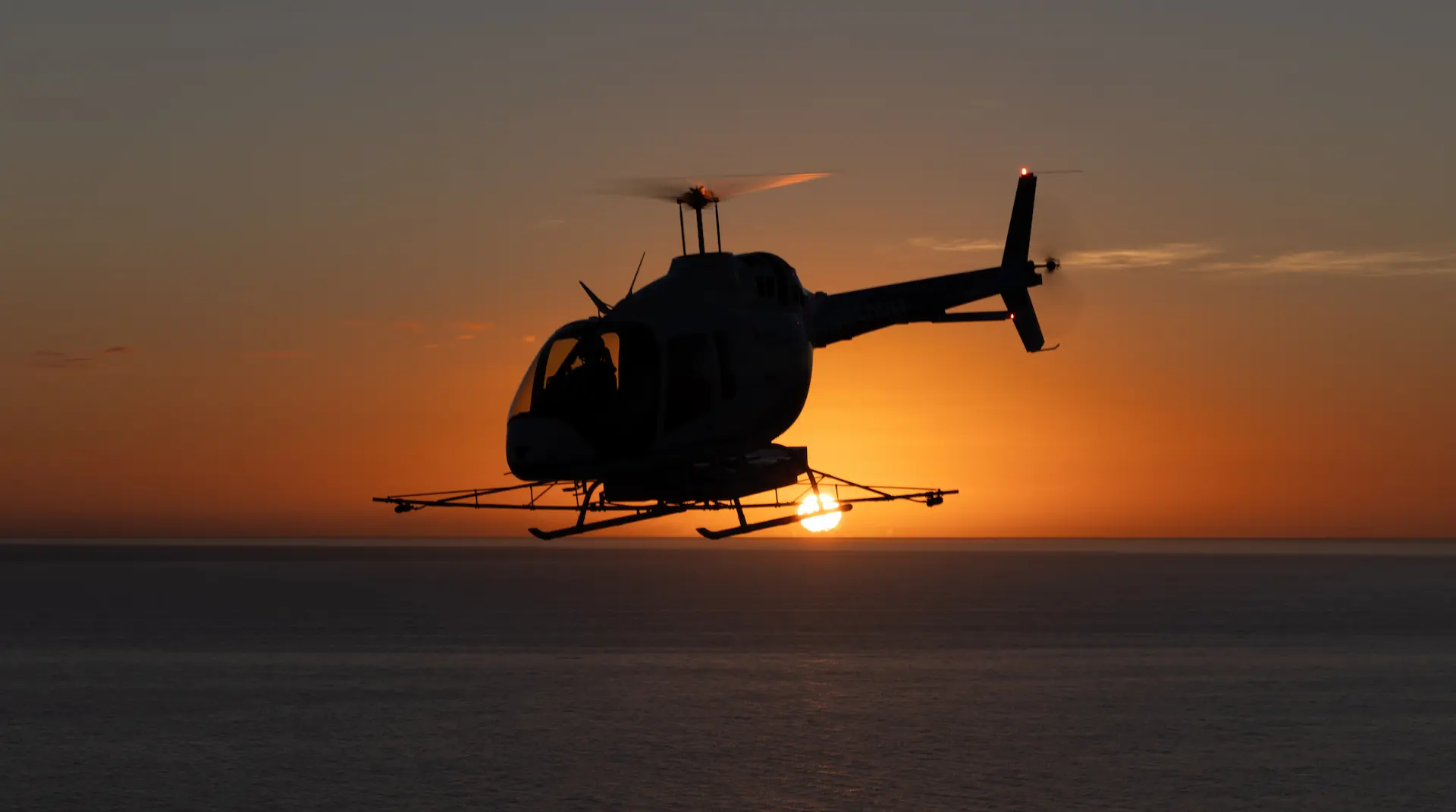
Transition
With no experience on the new type and Bell’s own flight school booked out at the time, Lewis hired an instructor from the Helicopter Institute to train him on the 505. “Coming out of a Blackhawk, it’s been eight years since I’ve flown anything this small. I really wanted an outside instructor who would come and train me in my helicopter, in my own area to maximize my familiarity for this specific operation, and I’m always looking for another set of eyes to add to the safety aspect,” Lewis remarked. Lewis’ type familiarization included a biennial flight review and took around five hours flight time, along with additional theory study. “Going through their academics as well as the flying really helped me get comfortable with this aircraft. Understanding how smart the FADEC is and how smart the brain of that helicopter is shows how much safer it is than the OH58, because this will throw a code and give me a warning light the instant anything starts to go wrong. Whereas in an old-school analogue 50-year-old Kiowa I’m not going to know until my oil pressure or temperature is pegged, or the engine just quits.”
Moving from the Army and the much bigger Blackhawks is a significant transition for Lewis, who had no previous civil flying experience and he remarked that he ended up at BMCD by pure luck. “I loved the flying and the Army, and I had envisaged taking it through to retirement but for my last four years in service I was living away from my wife and two young children, only getting to see them on weekends with a six-hour commute each way. That got really exhausting after a couple of years.” When Lewis had around eight months remaining on his commitment to the Army, he overheard a discussion about the BMCD position and agreed to have his name put forward for it. “I hadn’t thought I would be able to get a helicopter job in this area and had considered going to fixed wing but didn’t really know what I was going to do. Then this job fell into my lap, James interviewed me, and it was great, but it was pure luck.”
Lewis freely acknowledged his inexperience in regard to civil operations but expressed his appreciation for all the assistance and support he received from BMCD staff, industry professionals and other mosquito control pilots that greatly eased his transition. “At times it seemed almost overwhelming, but leaning on experts and the experience of those other professionals is what made it possible for me.” The operational aspect he initially found most challenging was the change to single pilot and single-engine operation. He elaborated, “Flying a two-pilot helicopter is great, you always have someone to back you up on navigation and on the radios but after flying on my own the first couple of time I realized that I had to change my mindset to the single-pilot scenario. I also had to change my mindset to single-engine because the twin-engine Blackhawk gives you massive comfort, being single-engine capable most of the time.” Because Lewis had already been flying the OH58, he found the hands-on flying transition to be relatively straightforward. “The 505 isn’t that different from flying the Kiowa. You jump in and it’s kind of like riding a bike, there’s a feeling of familiarity that came back almost immediately. It’s the change of mindset that was the most surprising aspect.”
Public use
As a public use operation, BMCD is not required to comply with the same regulatory requirements as a normal civil operator. However, like most public use agencies, BMCD attempts to operate in compliance wherever practicable. This makes the operation safer and more transparent, and Lewis noted that the industry-wide tendency to operate in this safer fashion is probably the reason that public use is still an available option under US Code. “I’m also fortunate that James is a very reasonable director. He has never pushed or pressured me to get the helicopter in the air or to start spraying. He hasn’t pushed me beyond my comfort limits, I’m completely new to this and the civil industry, it’s a new helicopter and a prototype tank so, very much like the Army, I’ve taken the crawl-walk-run approach here.” He commented that he would like to see the BMCD take on its own mechanic and intends to discuss that with the director and board in the future, noting, “That would also benefit the district. If an in-house mechanic could sign off annual inspections, then two annuals a year effectively pays for his salary because an annual on a helicopter that doesn’t need much still costs around thirty grand.”
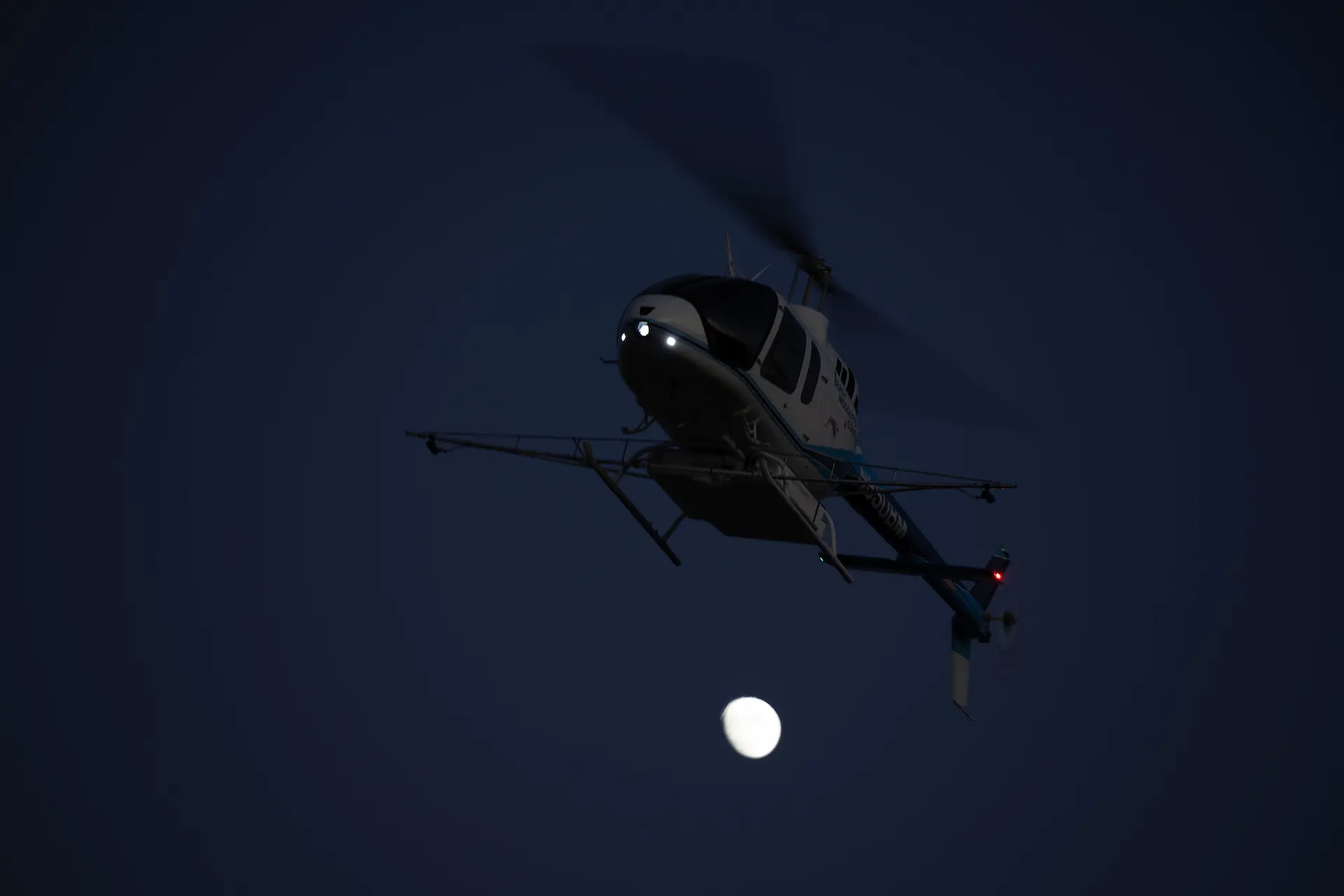
505 Aspects
Lewis stated that he is now quite comfortable and confident in the 505 but commented that he finds the controls to be quite stiff. “That’s not a problem when you’re flying, except when you’re coming in to land and are about eighteen inches from the ground. I think it’s going to loosen up in time, but it does make it difficult to be really precise and delicate when touching down. Even the pedals are quite stiff so it's tough to do real precise landings on that dolly.” His overall impressions of the 505 so far are overwhelmingly positive. “The LongRanger rotor system makes it very familiar to fly. It’s got the latest Garmin in it so that’s obviously awesome and the FADEC, rotor brake and air conditioning are all great. “I think it’s going to fit our role really well. If we had a bigger district or if I had to fly more frequently an Airbus might be nice with its increased capacity, but the capacity of the 505 is going to be just fine for our mission.” The 505’s gross weight limit means that Lewis can’t carry a full spray tank and full fuel, but he noted that the aircraft boasts an abundance of power and the BMCD operation seldom requires a heavy fuel load. “Even though I’m weight limited, at full gross weight that engine still has tons of extra power,” he observed. “I’ve never even had to use the maximum allowed takeoff power.”
Because ground trucks can control most of the small district much of the time, and effective larviciding with the OH58 results in decreased adult mosquito populations, the 505 should not see high flying hours and Lewis estimates an expected total combined flight time of around 120 hours each year. He is very positive about his job at BMCD, stating, “I am really enjoying this. It's great to be back with the family and I do enjoy this type of flying. It’s challenging being right down on the treetops in the 58 doing larvicide, that’s some of the most fun you can have outside of the Army. The next best thing I can think of is firefighting because slinging buckets is loads of fun, but no-one here in Panama City is doing much of that.” If the 505 was ever required for firefighting it would be feasible, as it boasts a gross weight almost 800lbs greater for jettisonable external (hook) loads than for internal loads. Firefighting is not a BMCD mission but Lewis remarked that he would be happy to pursue it if the board deemed it appropriate.
As time goes by the OH58 will undoubtedly become more expensive to maintain, with constantly increasing difficulty encountered in parts supply. Nevertheless, it is a practical option in the meantime as the BMCD does not support sufficient personnel to easily and practically switch between dry and liquid dispersal systems on a single helicopter. If Isolair was to design and build a suitable dry material spreading system for the 505, the venerable OH58 could feasibly be retired, but that would necessitate one of two changes. BMCD could hire engineering and support personnel to manage helicopter fit-out and potentially maintenance or, alternatively, a second 505 could be purchased to replace the 58, in which case dry and liquid setups could be permanently fitted. Disposal of the OH58 eliminates the undeniable safety deficit of having a pilot switch between two very different aircraft types, while going down the route of having two 505s would not only eliminate regular system change-outs, it would also add the redundancy inherent in having a ‘spare’ aircraft to cover maintenance and AoG occurrences.
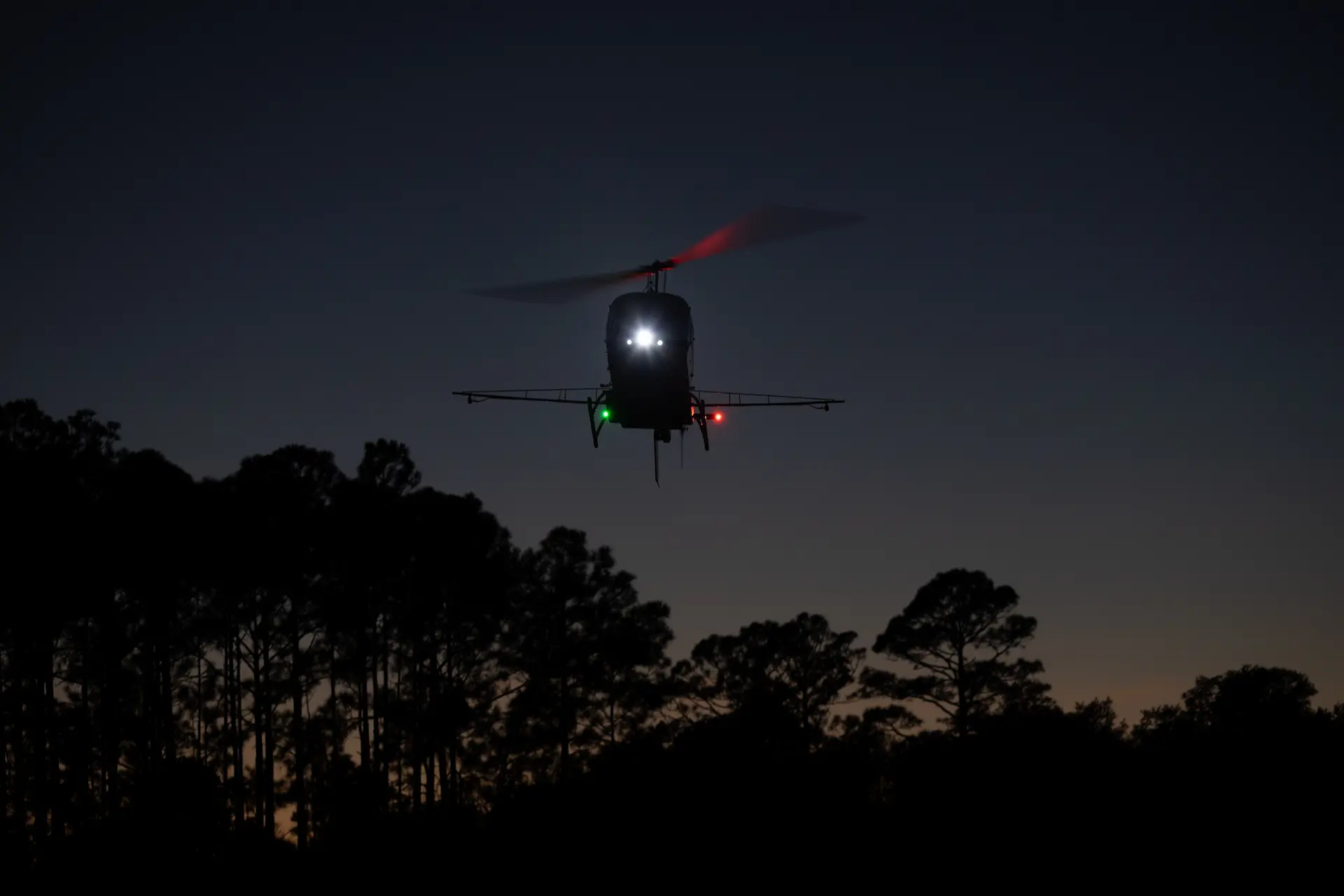
Although BMCD’s 505 has yet to fully prove itself in mosquito control operations, it looks to be an ideal choice for the role in many smaller areas. The aircraft’s modern design, Isolair’s new tank, the latest-generation avionics and high-tech mission-specific systems all should combine to make an affordable, reliable, safe, efficient and effective platform for aerial mosquito control.
 HOME
HOME


